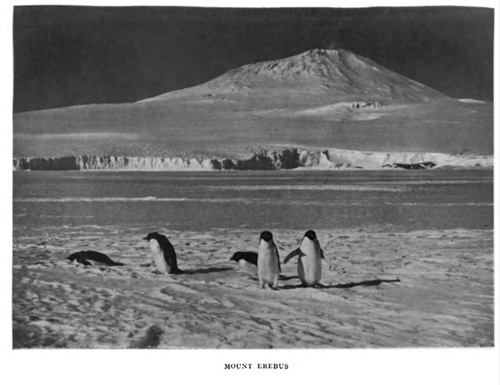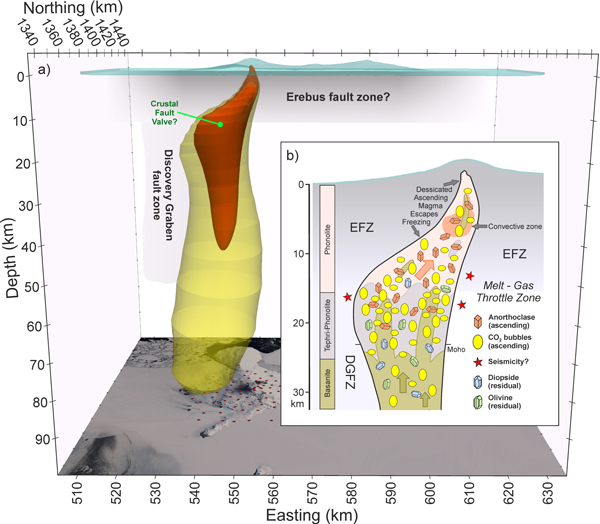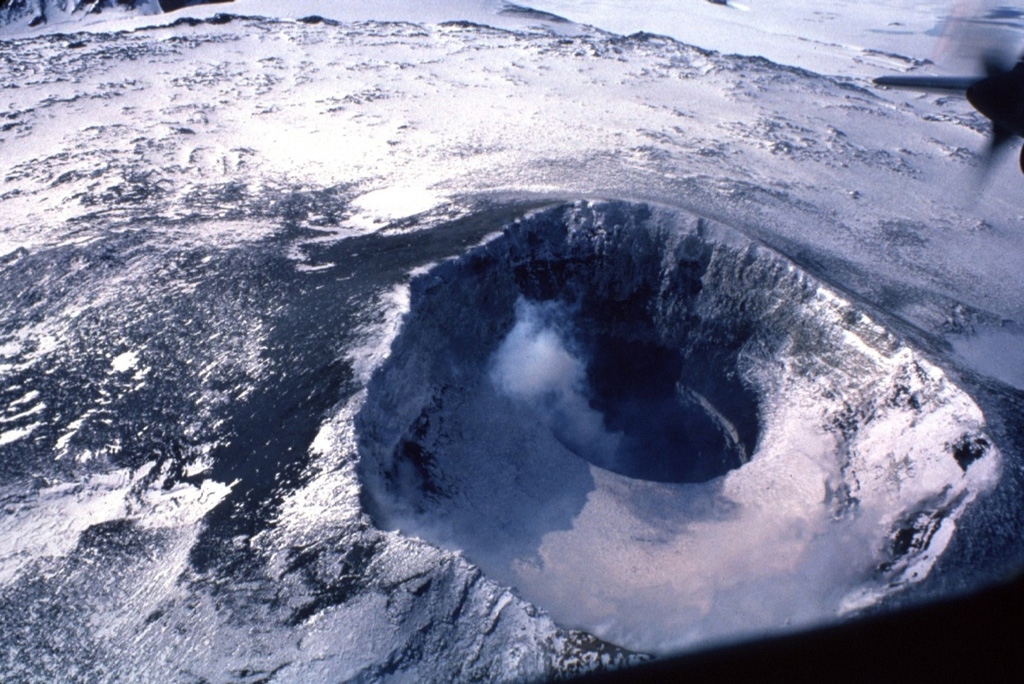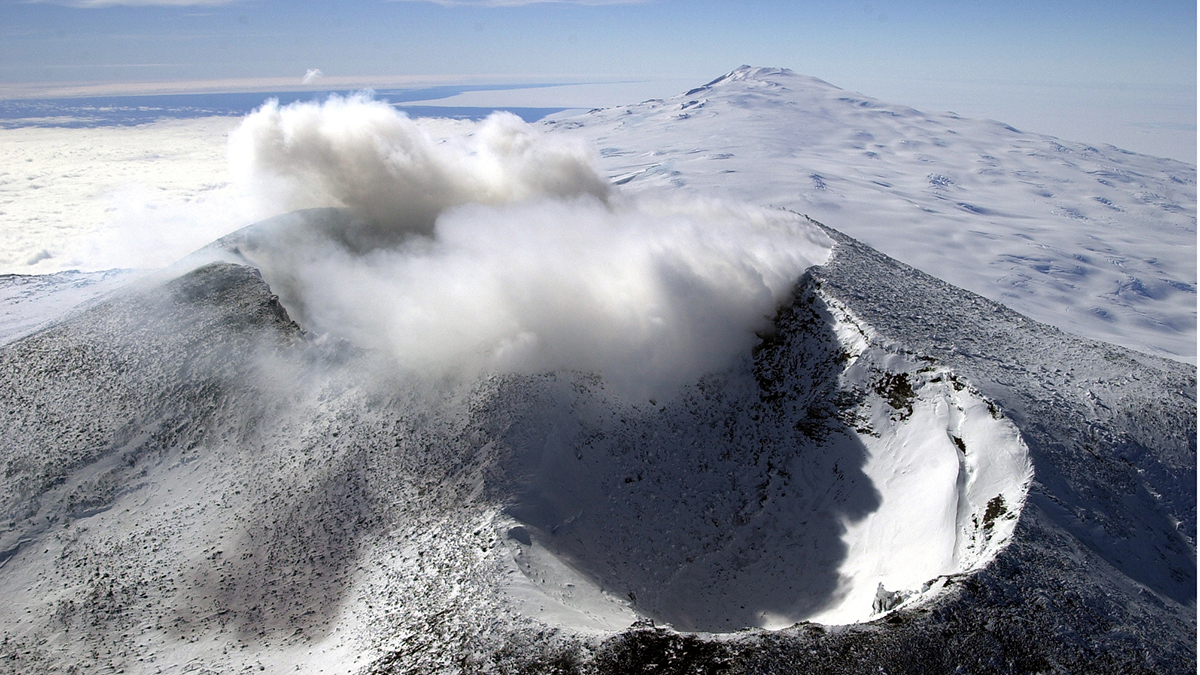One of Antarctica’s only active volcanoes is home to one of the few long-lasting lava lakes on Earth. The lake occasionally blasts out lava bombs from the summit crater of Mount Erebus, 3,794 meters high.
Now, research has revealed the plumbing underneath Mount Erebus that keeps the lake full.
Data taken by measuring natural electromagnetic waves traveling through Earth revealed the volcano’s magmatic system brings lava much closer to the surface than subduction arc volcanoes.
“This is the first great image of [a CO2-rich volcano].”
Unlike arc volcanoes such as the Cascades in western North America, Erebus has very little water in its magma. Instead, it’s rich in carbon dioxide (CO2). This dryness allows magma to travel much closer to the surface than water (H2O)-rich volcanoes that stall out at about 5 kilometers below the surface.
CO2-rich volcanic systems are less well understood than the more common H2O-rich arc volcanoes.
“If we can also get an idea of where the magmatic system is, you can better understand the monitoring data when these systems enter periods of unrest,” said lead scientist and geophysicist Graham Hill at the Institute of Geophysics at the Czech Academy of Sciences.
“This is the first great image of one,” said geophysicist Phil Wannamaker at the University of Utah, who participated in the work.
Fire and Ice

The snow-covered Mount Erebus is the southernmost active volcano on Earth and shares Antarctica’s Ross Island with three other volcanoes, all dormant. Mount Erebus overlooks McMurdo Station, and nearby sits the hut built by legendary polar explorer Ernest Shackleton and his men before they summited Erebus in 1908. Although its name ultimately harkens to Greek mythology’s personification of darkness, Captain James Ross named the volcano after one of his ships, the HMS Erebus, in 1841.
Past studies into Erebus relied on seismic data to probe its inner workings. Scientists use seismic waves traveling through Earth to ascertain the material below. But Erebus has very few crustal-scale earthquakes, hamstringing the method to shallow depths.
So Hill, Wannamaker, and their colleagues took a different approach: magnetotelluric data.
During summers between 2014 and 2017, the team visited Erebus via helicopter. They visited 129 sites on Erebus and Ross Island, taking exhaustive measurements. “Hats off to Graham for the energy and drive to cover the entire island,” said Wannamaker.
At each site, they’d recorded the natural electromagnetic waves that travel through Earth from the Sun and distant lightning bolts. “A lightning bolt is an impulsive antenna, if you will, and electromagnetic waves ripple out from that into your survey area,” said Wannamaker. Solar weather also produces waves that propagate through Earth.
Captured by custom “voltmeters” on the surface and fed into a modeling algorithm, the waves can create a 3D picture of the electrical resistivity of material below, “kind of like a CT scan of the human body,” said Wannamaker.

The picture below Erebus is “very glorious.” Areas with lower electrical resistivity indicate the material is hot and, to some extent, melted. The image shows a hot region that extends to at least 100 kilometers below Erebus. There is also a channel of melt going upward through the crust that feeds the volcano, the new research shows.
Using this method gave the researchers a much higher resolution: It gave them a continuous view from a few hundred meters to about 100 kilometers deep. “That’s an advantage over other geophysical methods, such as most seismology,” said Wannamaker. The resolution got fuzzier the deeper they looked, however.
In the image, a lower-resistivity area, likely magma, shoots toward the surface. This magma feeds the lava lake.
Clues from the Deep
“This material has been lurking down there,” said Wannamaker. This image “gives us some picture of the longer-term volatile recycling of the mantle and the crust, in particular to CO2.”
More commonly studied volcanoes like the Cascades are rich in water. Water is very volatile (it easily bubbles out of the magma like fizz in a soda), and as the pressure drops as it gets nearer to the surface, it can suddenly saturate the magma and cause an explosive event, like the 1980 eruption of Mount Saint Helens.

But Erebus is different. The magma’s birthplace in the upper mantle has little water, and the small amount of water it possesses disappears as the magma rises to the surface. The result is dry magma “reaching all the way to the very near surface, which is what we haven’t seen elsewhere.” The team published the results in Nature Communications last month.
Another notable feature in the new Erebus image is the magma skewing eastward as it nears the surface. For more than 200 million years, Antarctica was splitting in two at the West Antarctic Rift. The separation stopped 11 million years ago, but local movements on Terror Rift, which underlies Mount Erebus and other volcanoes, continued.
The magma reaches a choke point at the intersection of faults. There, magma and gas pressure build up in the lower middle crust. Occasionally, the magma and gas break through, carrying magma to the lake.
“Accessible” Mount Erebus
“This is a landmark study,” said Rick Aster, a professor at Colorado State University who was not involved in the new work. The latest findings address “one of the most remarkable features of Erebus volcano—that it has been able to sustain a convecting phonologic lava lake in its inner crater for at least many decades.”
Erebus is “one of the more accessible systems in the world.”
Although the new data are the most detailed yet, the researchers can’t see deeper into the mantle unless they take measurements over a larger footprint. A bigger footprint would require taking more measurements on sea ice and the ice shelf, like they did for about a dozen sites in the present study.
Surprisingly, Erebus is “one of the more accessible systems in the world, if not the most accessible,” said Hill. Although it’s far away, “you have none of the other restrictions of forest cover and accessibility. You can pretty much go anywhere on Erebus to make your measurement.”
—Jenessa Duncombe (@jrdscience), Staff Writer

